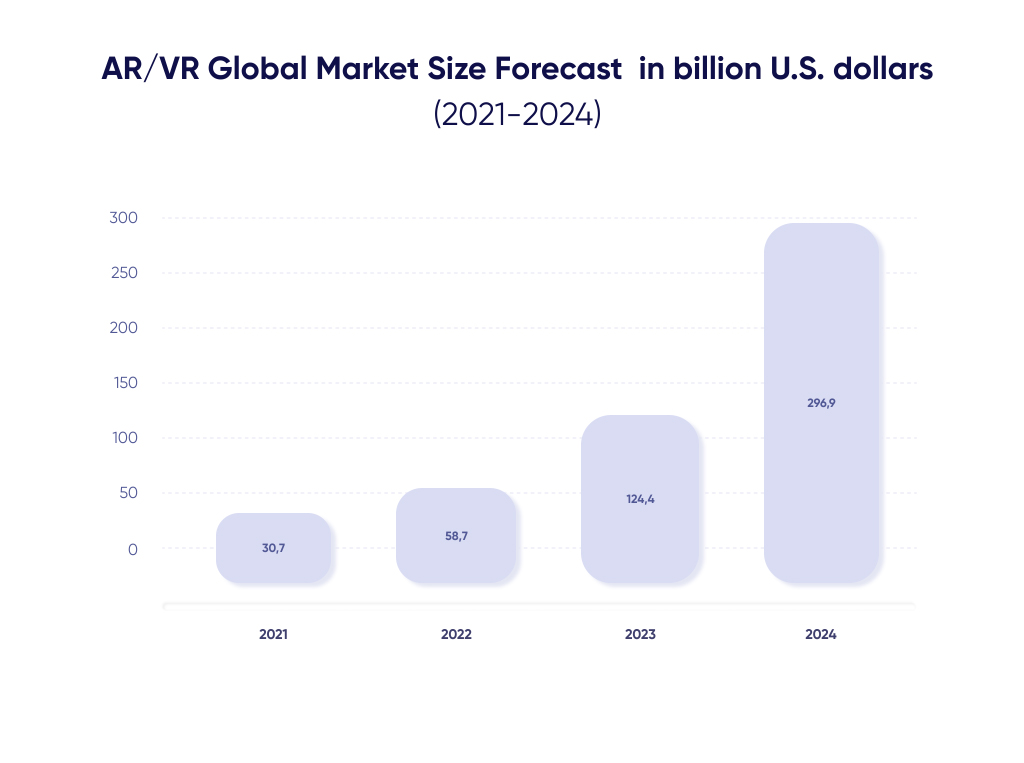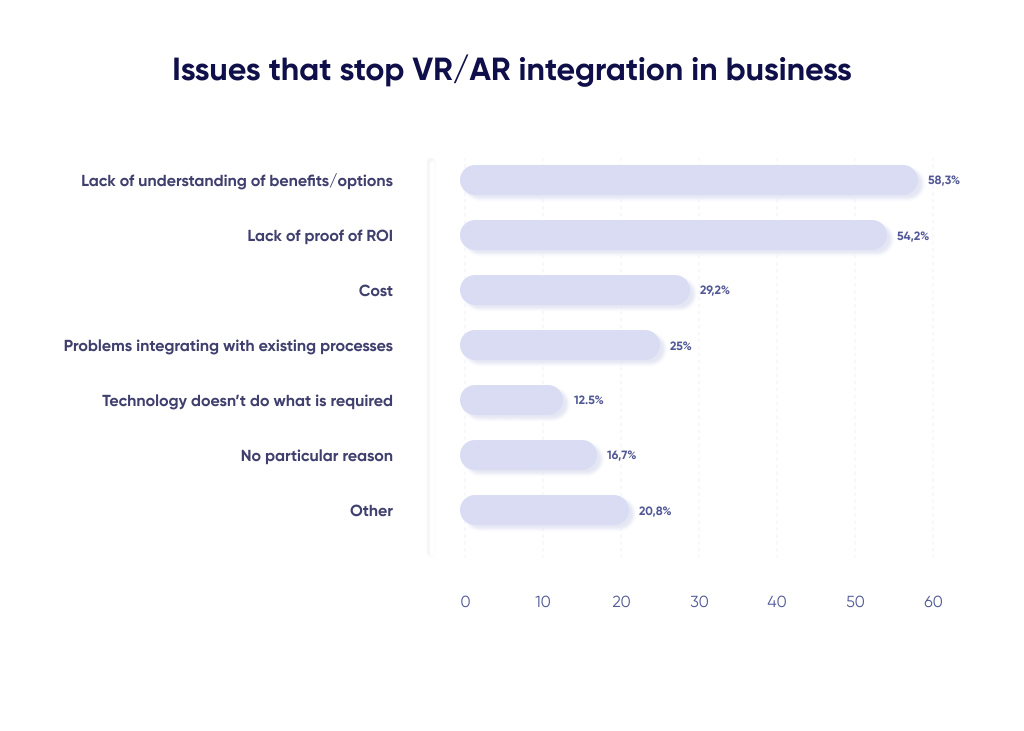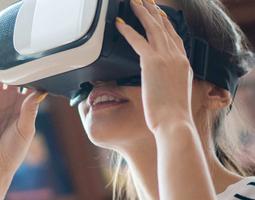Virtual reality in education (or any other industry, really) has always been a great example of significant advancement in technology. At the end of the XXth century, it seemed like we'd find augmented reality and virtual reality only in sci-fi movies. Still, it took only 20-30 years to turn AR/VR sets into common devices used for entertainment, education, marketing, and business.
It’s no secret that the gaming and entertainment industry has the highest percentage of AR/VR adoption. The main reason for that is its large and diverse audience willing to experiment with the latest technological innovations. But in 2023, virtual reality is so much more than another entertainment tool. Entrepreneurs have finally unlocked VR’s potential and enjoy numerous business benefits it brings.
AR/VR is now an integral part of various business areas, but we’ll focus on education. If you’d like to find out how to incorporate virtual reality in different types of educational business or about multiple perks VR can offer, be sure to read this text to the very end!
Virtual reality in different types of educational business
The greatest asset of virtual reality technology in education, for sure, is its versatility. VR sets are perfect for keeping kids interested and involved in the learning process. Still, they also help adults to obtain specific skills that would be hard to master elseways. Whether it’s elementary school education, higher education, or industry-specific training, VR can make the process easier.
How to use virtual reality in medical education
Healthcare is one of several industries where the price of a human mistake may be just too high. And even though it is impossible to exclude errors completely, the introduction of VR sets into the educational process will increase the quality of the medical staff and improve the overall level of vocational training.
- No-risk “learn by doing” process
People learn faster and better if they can practice the skill rather than just study and memorize theoretical information. The “learn by doing” technique is essential for medical training as you can’t become a qualified medical pro without actual engagement with patients.
Mixed reality in medical training helps to take the pressure off as the trainees can make mistakes and work on their precision without harming anyone.
- A better understanding of physiology
Mixed reality experience is a fantastic tool that helps understand human physiology better. Through the use of functional sets, you can not only read about the particular condition, you can actually see it and interact with it.
UCLA’s “Surgical Theater” is an excellent example of VR in education. Surgeons can practice complex, highly precise operations in virtual reality before actually performing those on patients. The advanced imaging capabilities (e.g., dynamic segmentation or 3D points of view) provide the top level of precision and make the examination process easier.
- Improved doctor-patient interaction
One of the most challenging stages of the medical training process is the actual interaction with the patients. Some people are afraid of doctors in general, others are scared of invasive procedures, and the doctor must “find the key” even to ”difficult” patients.
A unique VR environment developed at Goldsmiths, University of London allows medical professionals to interact with virtual patients just like they would in an actual consultation. By working with diverse VR scenarios, medical trainees deal with fewer problems during consultations and are capable to understand the patients’ needs better.
Virtual reality in elementary education examples and perks
For the new generation, mixed reality is often synonymous with entertainment. The use of VR sets instantly increases the students’ level of engagement and excitement. Therefore, if your business is related to elementary education, AR/VR can equip you with an essential competitive edge.
In 2023 VR education is no longer perceived as “weird” or “unnecessary.” Teachers are enjoying it just as much as students do. As a survey by Samsung claims, 85% of teachers are sure that the introduction of virtual reality will positively affect the educational process. The teachers have even named the subjects VR is most suitable for (the top three include science, history, and social studies).

The prevalent examples of VR in elementary education include virtual field trips, mixed reality tours, and remote learning. No doubt, some subjects do not require virtual reality “intervention” like math or grammar. Still, VR can be a powerful tool helping to keep the students focused and improve engagement when it comes to art, history, or even literature. For now, Google remains the market leader in this field, offering expeditions on the Google Arts & Culture platform. The subjects covered by expeditions include science, art, geography, and natural history. The pupils can tour the most famous sights, recreate the interaction experience with dinosaurs, and travel the world while still staying at school.
The reason for the increasing acceptance of virtual reality education for elementary educational facilities is an outstanding number of assets no school should neglect.
- Cost-effectiveness
Even though AR/VR headsets are not that cheap for now, those still are a good investment as it still costs less than an actual field trip (especially if we’re talking about a trip abroad).
- A flawless immersive experience
Thanks to the innovative AR/VR solutions, the students receive a real-life sense of presence. The human brain quickly adapts to virtual reality, and your whole body starts to believe you’re actually in a new place.
- Fuel for emotional reactions and creativity
This is especially important for elementary education as many children have ADHD and/or get bored quickly. VR experiences are memorable and introduce a new way of teaching that boosts students’ creativity. What’s better, it works not only for such subjects as art or history but also for science and engineering.
- Students’ willingness to experiment with technology
The older generation may be hesitant towards virtual reality, but Gen Z grew up with technology, and VR doesn’t scare them. Students will love these kinds of lessons as they are different from the traditional learning methods.
Virtual reality in higher education. Is it worth it?
VR technology in education can be beneficial not only for the younger audience but also for the students aiming for higher education. Training becomes more specific, career-oriented, and virtual reality classes may become a beneficial tool every student will appreciate.
One of the most common cases for VR use in higher education is highly technical training. It’s essential for many industries, including medical training mentioned above, military career, engineering, law, etc.
VR can do so much more than provide simulations that are good only for elementary school! Virtual labs (like the ones Labster has created) help students conduct the necessary experiments and research (e.g., culture bacteria or visualize chemical reactions). Virtual naval ships and pilot training programs are vital during comprehensive military training. Virtual galleries (like the one Kremer Museum has offered) are of great use to anyone studying art. The list is nearly endless.
Another “secret power” of virtual reality in education is its perfect fit for internships. VR training courses can allow anyone to take on a particular role, give multiple careers a try, and see which one fits.
VR is also a weapon effective against high dropout rates, which is a major problem for higher education institutions. Highly interactive and immersive virtual reality classes keep the students interested. Consequently, education is no longer seen as a burden or a duty. It is perceived as a fascinating yet helpful experience you’d like to revisit.
Benefits of virtual reality in education
The global AR/VR market, which is about to reach 296.9 billion dollars in 2024, is growing for a reason. The VR sets manufacturers are trying to meet the customer demand. At the same time, the educational facilities are willing to adopt the latest technological innovations to reap numerous benefits virtual reality can offer.

Not to claim without evidence, let’s list the most exciting perks of virtual reality for education.
- Better environment for group learning
The traditional teacher-centered approaches may have been quite effective for years. However, in the XXI century, students have access to an unlimited number of information sources, and this method is losing its power. Students are willing to work together, discuss the educational content, and enjoy cooperation and debate.
VR is perfect for that because it can be used during online learning sessions and because the avatars provide a certain level of privacy and user anonymity. Thus, even the students that struggle with social adaptation feel calm, relaxed, and confident.
- Designed both for distance learning and conventional teaching
The global pandemics forced educational institutions to adopt the latest e-learning trends. Isolation and social distancing have limited the opportunities for traditional student-teacher and student-student interactions.
The VR experience came in handy during the pandemics to save multiple subjects like biology, chemistry, or physics. Virtual reality brings laboratory experiments to life without any risk for the students’ or the teachers’ health.
What’s more important, AR/VR sets are equally valuable during online lessons and in the classroom. This hardware will never be abandoned or unwanted.
- Improves inclusivity
Another point proving that virtual reality and education is a match made in heaven is the VR’s ability to involve students with special needs in the educational process. Virtual reality experience doesn’t feel awkward or frightening. On the contrary, it creates a safe environment great for therapeutic exercises and careful information processing.
- Increase brand awareness and brand loyalty
At first, this one may seem irrelevant for the educational industry, but it is essential. Educational facilities are striving to build a solid brand to attract more students as well as investors. Take the Ivy League as an example. It's an educational brand known all over the world. The brightest students from different countries do whatever it takes to get accepted.
These days you can’t build a sustainable, trustworthy brand without the willingness to adopt innovative technology. On the other hand, schools, colleges, and universities that have successfully introduced VR practices get extra points from students and philanthropists.
What’s even more interesting, it doesn’t have to be VR classes only. Some universities and colleges in the United States and Europe offer VR campus tours that students genuinely enjoy!
- Boosts cultural competence
We live in an interconnected society where cultural competence is highly valued as an essential skill for any intelligent human being. It may be highly beneficial to use VR for education as well as cultural and moral development. It is a sure-fire way to ensure that the younger generation grasps the essence of cultural diversity.
Virtual field trips, museum tours, and language lessons expose students to other countries and teach them respect and appreciation.
Challenges of AR/VR in education
It wouldn’t be fair to avoid this topic altogether because there have to be cons if there are pros. And there certainly are. A study by Statista shows that more than half of potential AR/VR users simply don’t understand how this technology can help them, and nearly 30% find the virtual reality integration too expensive.

Is it the full list? Sadly, it’s not. One of the greatest challenges is the lack of first-rate VR content (especially in regards to VR and education). There are some significant players on the VR market like Google, Sony, and Samsung, but it’s still not enough to cover the growing customer demand.
Besides, even though the global AR/VR market is evolving, the virtual reality adoption rate in colleges, schools, and universities is distinct in every country. The “headsets in every classroom” plan may be valid for the US, China, Japan, Canada, or Western Europe, but it is not that realistic for some other parts of the world. At least for now.
Conclusion
We’re living at the dawn of the virtual reality era. This industry is far from reaching its peak. But the fact that even modern AR/VR solutions can help people so much is breathtaking. While more conservative business owners bet on conventional and well-accepted educational products, others don’t mind the risk-taking and bank on virtual reality in education and win!
Of course, there are cases when virtual reality is not that useful even in the educational industry, but these cases will become less and less common as time goes by. And if you’d like to incorporate an innovative VR solution into your business model right now, contact Light IT, and our team of highly skilled experts will find a way to do that and bring your business to the next level.





